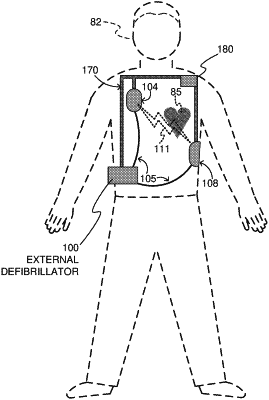| CPC A61B 5/316 (2021.01) [A61B 5/6805 (2013.01); A61N 1/3904 (2017.08); A61N 1/3925 (2013.01); A61B 5/333 (2021.01); A61N 1/0484 (2013.01); A61N 1/3968 (2013.01)] | 16 Claims |

|
1. A wearable cardioverter defibrillator (WCD), comprising:
a support structure configured to be worn by a patient;
an energy storage module configured to store an electrical charge;
a discharge circuit coupled to the energy storage module;
electrodes configured to render an electrocardiogram (ECG) signal of the patient while the patient is wearing the support structure;
a user interface configured to output an alarm in response to a noise alarm signal; and
a processor configured to:
receive the ECG signal,
analyze the ECG signal to determine whether a shock criterion is met,
determine whether high frequency noise and/or high amplitude noise is present on the ECG signal,
cause the user interface to generate the noise alarm signal responsive to a determination that high frequency noise is present on the ECG signal and the shock criterion is met, and cause the user interface to not generate the noise alarm signal responsive to a determination that high frequency noise is present on the ECG signal and the shock criterion is not met,
responsive to a determination that high amplitude noise is present on the ECG signal, cause the user interface to generate the noise alarm signal for a predetermined amount of time and suspend analysis of the ECG signal to determine whether a shock criterion is met.
|